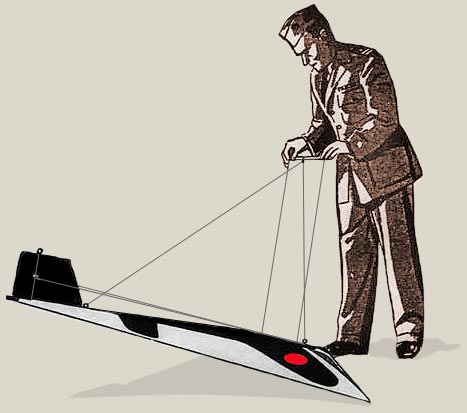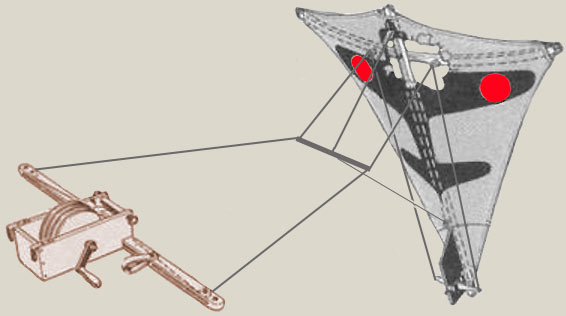|
Target
Kite Mk.1,2
Thank
to Embassy of the United State (France) |
| Wokipi-Kite |
|
Extract of Manual : General Description |
EQUIPMENT | |
| MANOEUVRES |
| U.
S. Navy Target Kites
are designed to serve as maneuverable aerial targets for gunnery training,
from ground or ship. Toutes les cibles ont certains avantages et inconvénients. La seule cible parfaite est l'avion ennemi, mais au moment où il apparaît il est déjà trop tard pour s'entraîner. N'importe quelle cible qui contribue à améliorer l'adresse au tir est valable. All targets have certain advantages and disadvantages. The only perfect mark is an enemy airplane, but by the time that appears it is too late for practice. Any target which contributes to improvement in marksmanship is worthwhile. Because of the kite's natural ability to ascend in a wind it becomes a "natural" as an air target, but an ordinary kite is too easy a mark for modern gunnery requirements. The Navy's kite was therefore made maneuverable. It differs from the kites of our boyhood in four ways : It is well designed aerodynamically; it requires no tail; it has a rudder; and it flies with two lines. It is properly designed and built; if it is properly assembled and adjusted and intelligently handled it can perform evolutions which require the gunner to develop high skill to track it and shoot it down. The Mark 1 kite is five feet in size, weighs slightly under two pounds, and needs a ten-knot wind for flight. The size of the sticks is required by the stress which the kit undergoes in maneuvering or being towed, as well as the need to withstand injury when hit by bullets. The two flying lines serve as control cords to steer the kite |
 |
| around the sky. Pulling either one moves the bridle stick which is connected to the rudder by tiller cords. A slight movement of the rudder slants the kite and causes it to move off to one side. A full movement brings the kite around in a loop; these can be made to right or left, or alternated to form figure-eights, either vertical or horizontal. A full movement quickly followed by a straightening of controls inverts the kite, diving it vertically. Nearing the earth another full- movement brings it upright and it rises by its natural kite action. |
 |
The area of its maneuvering is about ninety degrees wide and seventy
degrees high; it is faster in higher winds--usually about twice that
of the natural wind--and even faster when diving. The usual distance from kite operator to kite is about 200 yards, but if greater range for the gunner is desired, the operator can be located at any distance from the firing line. The Target Kite has numerous advantages: Its movements simulate those of an airplane; shooting it down gives the gunner the psychological satisfaction of a victory; it remains aloft for a useful duration of firing; it does not require complex apparatus nor numerous personnel for operation; and it is inexpensive. The Mark 1, Mod. 1 kite is specially designed for use at sea--to sink rapidly when lost or shot down, so that no trail of floating debris will indicate the ship's position. |
| To stimulate
the interest of the gunner, a silhouette of
an enemy airplane is printed on the cover. The ground color
being atmosphere blue, the outline of the kite merges into the sky
so that the airplane is more prominent. Note that the most important
target area of the airplane silhouette, represented by the pilot's
cockpit, engine and tanks, is also the most vulnerable point of the
kite-the cross axis. The silhouette being about one-ninth the size
of the actual fighter, the simulated distance becomes nine times that
of the line-length, and the speed of the kite also appears proportionate
for an actual airplane at the simulated distance. A downed kite when recovered can be easily put back into service by inserting a new stick, knotting a severed line, or patching the cover. Spares come with each issue, and more can be readily manufactured on the station. Thus, the original quantity issued can be extended by intelligent use and ingenious repair; but even if the kite is completely lost the cost is small--less than four dollars and a half. Also--it's a lot of fun to fly it. |